
The Asclepiadoideae are a subfamily of plants in the family Apocynaceae. Formerly, it was treated as a separate family under the name Asclepiadaceae, e.g. by APG II, and known as the milkweed family.
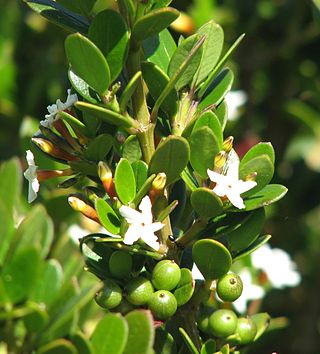
Alyxia is a genus of flowering plants in the family, Apocynaceae. It contains at present 106 species, but Alyxia stellata and A. tisserantii are very variable, might be cryptic species complexes, and are need of further study. It consists of shrubby, climbing or scrambling plants. This genus occurs in China, the Himalayas, Southeast Asia, Australia, New Caledonia and the Pacific Islands. There are 14 species in Australia, 21 in New Caledonia and 7 in the other Pacific Islands, including Hawaiʻi.

Cynanchum is a genus of about 300 species including some swallowworts, belonging to the family Apocynaceae. The taxon name comes from Greek kynos and anchein, hence the common name for several species is dog-strangling vine. Most species are non-succulent climbers or twiners. There is some evidence of toxicity.
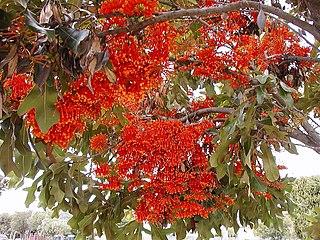
Stenocarpus is a genus of about 22 species of flowering plants in the family Proteaceae. They are trees or shrubs with variably-shaped leaves, zygomorphic, bisexual flowers, the floral tube opening on the lower side before separating into four parts, followed by fruit that is usually a narrow oblong or cylindrical follicle.

Geniostoma is a genus of around 49 species of flowering plants in the family Loganiaceae. They are shrubs or small trees, with inflorescences borne in the axils of the simple, petiolate, oppositely-arranged leaves. The flowers are arranged in cymes, and each is pentamerous.
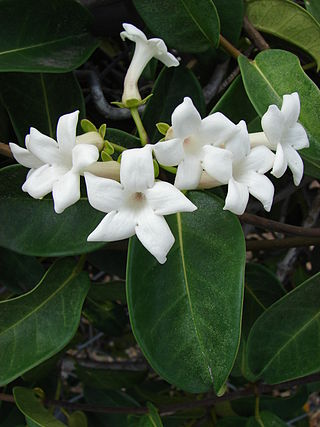
Marsdenia is a genus of plants in the family Apocynaceae first described as a genus in 1810. It is named in honor of the plant collector and Secretary of the Admiralty, William Marsden. The plants are native to tropical regions in Asia, Africa, Australia, and the Americas.

Vincetoxicum is a genus of plants in the family Apocynaceae. Although the species in Vincetoxicum have sometimes been included in Cynanchum, chemical and molecular evidence shows that Vincetoxicum is more closely related to Tylophora, now included in Vincetoxicum. The generic name means "poison-beater" in Botanical Latin because of the plants' supposed antidotal effects against snakebite.

Xanthostemon is a genus of plants in the myrtle family Myrtaceae, first described in 1857 by the German–born Australian botanist Ferdinand von Mueller. The genus is distributed across Malesia, Papuasia and northern Australia. The genera Pleurocalyptus and Purpureostemon from New Caledonia are morphologically close to Xanthostemon.

Parsonsia is a genus of woody vines in the family Apocynaceae. Species occur throughout Indomalaya, Australasia and Melanesia.

Gahnia is a genus of sedges native to China, Southeast Asia, New Guinea, Australia, New Zealand and a number of Pacific Islands. The common name is due to the toothed margins. It often forms tussocks.

Pleioluma is a genus of flowering plants in the family Sapotaceae. It includes 40 species of evergreen hermaphroditic or gynodioecious trees, reaching up to 25 meters tall.
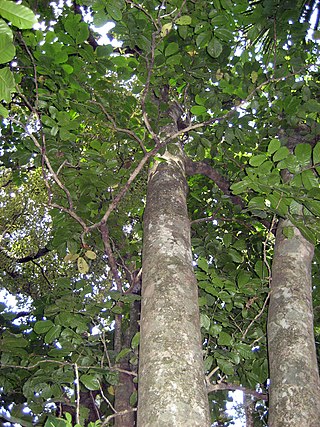
Didymocheton is a genus of flowering plants in the family Meliaceae. It includes 41 species which range from eastern India through Indochina and southern China to Malesia, Papuasia, eastern Australia, New Zealand, and the South Pacific.
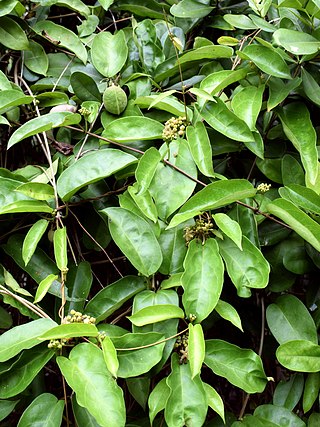
Sarcolobus is a plant genus in the family Apocynaceae, first established as a genus in 1809. It is native from Bangladesh through Southeast Asia, to New Guinea, Australia, and certain islands of the Western Pacific.
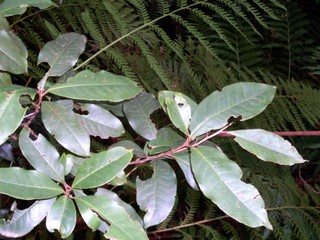
Quintinia is a genus of about 25 evergreen trees and shrubs native to the Philippines, New Guinea, New Zealand, New Caledonia, Vanuatu and Australia. Plants have alternate leaves. White or lilac flowers form at the end of stalks or on leaf axils. The fruiting body is a capsule, usually containing a large number of tiny seeds. The genus is named after the gardener Jean-Baptiste de la Quintinie.
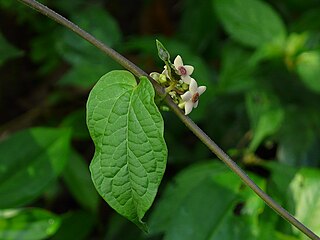
Heterostemma is a genus of plants in the family Apocynaceae, first described in 1834. It is native to India, China, Taiwan, Southeast Asia, Australia, and certain islands in the Pacific.
Leichhardtia mackeeorum, synonym Marsdenia mackeeorum, is a species of vine in the family Apocynaceae. It is endemic to New Caledonia.

Seringia is a genus of about 18 species of plants in the family Malvaceae. Species of Seringia are native to Australia, New Guinea, and Madagascar. They are small shrubs with soft silken leaves. The flowers are purple or mauve and appear in profusion. The calyx is the most conspicuous part of the flower.















